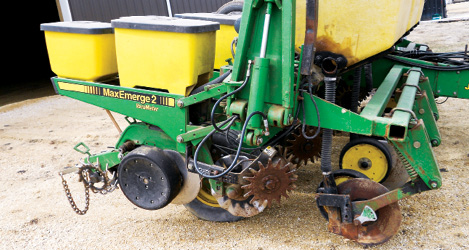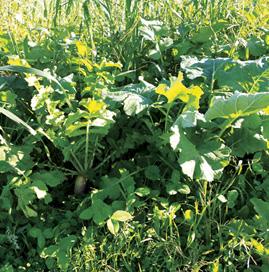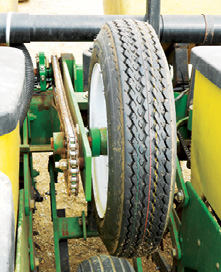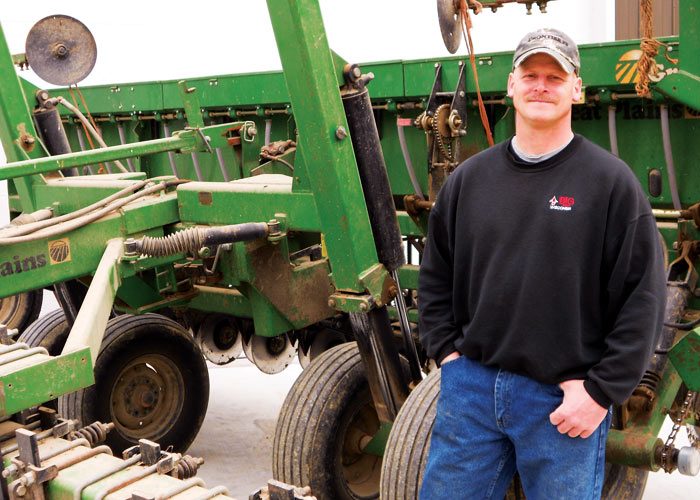NAME: Roger Bindl
LOCATION: Spring Green, Wis.
FARM: Bindl Farms
YEARS NO-TILLING: 8+
ACRES: 210 acres
CROPS: Corn, Soybeans, Winter Wheat, Alfalfa
While I only truly count myself as being a no-tiller for the past 8 years since I started farming on my own, I’m no stranger to the practice. Of the 210 acres I farm, all but 38 acres are considered Highly Erodible Lands (HEL). The land my father, Wayne “Buzz” Bindl, farmed was similar and I’m sure this was one of the driving reasons he started no-tilling back in the early 1980s.
When he first started, he was no-tilling corn on strips. I can’t be sure of all his reasons for going no-till, but the main motivations for me picking up the practice when I started my own farm were saving fuel and time. Plus, I really do hate to see all that black dirt get washed away by rain.
Over my years of no-tilling, both on my own and sharing equipment with my dad, we’ve made a fair number of changes on the planter to better fit my needs, we’ve introduced cover crops and started raising winter wheat. I am constantly testing out new ways to improve my yields and efficiencies, while reducing costs where possible.
In addition to farming, I raise around 90 head of dairy replacement heifers ranging from calves in hutches to some that are just fresh (recently calved). Some of the changes I’ve made have also improved my ability to use their manure in my fields.

PREPPED FOR ALL OCCASIONS. Bindl does some custom planting, leading him to use some attachments that work across a variety of field conditions. Yetter Sharktooth residue managers, Jamison drive kits, Precision Planting’s eSet meters, Schaffert Rebound seed covers, Schlagel Posi-Close wheels and drag chains get the job done no matter the field conditions.
Back Home
I made my solo debut in farming when my grandfather’s farm — in picturesque rolling hills of Wisconsin’s Driftless Area near Spring Green — came up for rent and I snapped it up. The previous renters had farmed conventionally, with the farm in continuous corn and alfalfa.
That first year I hired a custom seeder with a Great Plains no-till drill to seed another 15 acres of alfalfa. I then no-tilled 50 acres of corn and 40 acres of soybeans into standing corn stalks with my 6-row John Deere 7200 no-till planter.
Standing stalks where a frustration. They constantly where knocking the drive chains off the planter and causing it to plug.
Those initial struggles spawned what became the first of many planter modifications my father and I made over the years. I took the planter back to the shop and used some angle iron to make guards for those drive chains so they would stay on. It was trial and error at first, but I managed to get everything planted.
I’m still using the same planter today, but I’ve added Yetter Sharktooth residue managers, Jamison drive kits, Precision Planting’s eSet meters, Schaffert Mfg. Rebounder seed covers, Schlagel Posi-Close wheels and drag chains.
The Jamison drives, also known as Upper Wheel Drives, eliminated the problem with corn stalks knocking off my drive chains. Most planters attach the drive chains to the wheels that carry the planter itself, putting the chains in close proximity to any standing corn stalks.
The Jamison drive kit consists of a second wheel that mounts between the corn planter boxes. When you set the planter down, the Jamison wheels drop down on top of the drive wheel. The contact makes them turn as you drive. The drive chain is then attached to the Jamison wheel, well above any stalks.
Since I’ve installed these drives I haven’t had any issues with corn stalks knocking my drive chains off. While it’s not much of an issue in my own fields anymore as I don’t do much, if any, corn-on-corn, I do a fair amount of custom planting where I run into the issue.
My custom planting is where the Yetter residue managers are used most, too. The way my rotation is set up, I’m usually planting corn into alfalfa or cover crop residue and the residue managers aren’t as necessary for those situations.
I just installed Precision Planting’s eSet meters this year. I’m hoping they will improve my seed singulation and spacing and help me get to that magic picket fence stand we’re all looking for.
As for the Schlagel Posi-Close wheels, their bent-rod tooth design just seems to work the best for me to close the trench and give me good seed to soil contact. I have a lot of different soil types and I’ve found those work best across all soils and varied planting conditions.
After that first year, I bought my own 15-foot Great Plains center-pivot-hitch drill for no-tilling soybeans, but wanted to use it to seed alfalfa, too.
After mounting a small grains box on it, I’m now able to use it for seeding soybeans, alfalfa, wheat and cereal rye cover crops following corn, as well as cover-crop mixes following wheat. For the cover-crop mixes, I place the smaller-seeded species in the small grains box and the larger-seeded species in the big box.
Planting Ideas
Cover crops are an idea I brought home from my first National No-Tillage Conference in 2011. I went to Cincinnati by myself not knowing what to expect, just planning to be a fly on the wall and absorb all I could about no-till. The amount of information available was almost overwhelming, but I did come home with the idea of trying out tillage radishes as a cover crop.
I knew I had compaction in some of my fields as there were places where water would sit a bit longer than it should after it rained. I figured the tillage radishes could help break up that compaction.
The guys at the conference said you could broadcast the radishes into soybeans when the leaves started turning yellow. I bought a bag and was only doing it on a few acres as an experiment. I just threw some seed in a pail and walked through the waist-high soybeans manually spreading the seeds.
Based on what few plants did germinate, I knew there had to be a better way. Although some people might have written the whole thing off as a failure, for me it’s not a failure if you learn something.
What I decided was that for my area it would probably be better if I could get the radishes seeded much sooner. My solution was to add winter wheat to my rotation.
Now I harvest my winter wheat around the end of July, bale up the straw for use as bedding for my livestock, spread manure and use the Great Plains drill to seed cover crops by mid-August. It’s a system that’s been working wonderfully ever since.
Adding wheat to the rotation had some great benefits beyond being a placeholder for cover crops. Combined with cover crops, it provides an ideal opportunity to use my livestock manure with no-till. I’m able to get it out in a timely manner and the cover crops are there to utilize and hold the nutrients.
Cover Review
I’ve now gone beyond just radishes to planting cover-crop mixes. While they do change from year to year, the mix generally includes oats, radish, Austrian winterpea, hairy vetch and red clover.
This mix provides me with nitrogen (N) for the corn crop that will follow and really mellows the soil. My planter pulls so much easier in the fields where I’ve used cover crops. My crops and input budget have benefited, too.
One year I got the unexpected opportunity to test out my cover crops. I had a field where the wheat crop winterkilled on the north half but survived on the south half. I replanted the north half to corn and went on with the wheat and cover crop rotation on the bottom.

MAKING ROOM. Adding winter wheat to his rotation gave Bindle extra crops of grain and straw, plus allowed him to plant diverse cover crop mixes after the early harvest. With cover crops, Bindle has found he’s able to reduce his in-season N rates by 30-40% in the following corn crop with his mixes.
The next year I planted the whole field to corn. At planting, I was able to pick up 0.3 mph where the cover crops were planted as opposed to corn-on-corn. As the growing season went on, you could visibly see the line in the growing corn. The half that was in cover crops was noticeably greener.
I also took advantage of the situation to do a fertilizer test plot. For starter I used 75 pounds per acre of DAP 9-23-30, plus 25 pounds per acre 21-0-0-24S in a 2-by-2 placement applied with the planter. The in-season application was a broadcast of 350 pounds of urea.
I split the field north to south and east to west to make four, 1-acre fields. In one quadrant I had corn-on-corn with just starter fertilizer; the second quadrant was corn-on-cover crops with starter; the third was corn-on-corn with starter plus in-season N; and the fourth was corn-on-cover crops with starter and in-season N.
There were big differences in the plots. The corn-on-corn with starter only averaged 70-80 bushels, while corn-on-covers with starter only yielded 150 bushels. Corn-on-corn with starter and in-season N yielded 200 bushels per acre. The big winner was corn-on-covers with starter and in-season N, which yielded 220 bushels per acre.
This information confirmed the benefits of cover crops for me. It also gave me the confidence to decrease by 30-40% the amount of urea I use for the in-season N application in corn following my cover-crop mix.
Adding wheat and cover crops to my rotation has clearly been a benefit. I’m able to get rid of excess manure, plant my cover crops earlier, plus I use the straw for bedding and sell some straw, too. That’s all on top of selling the grain.
Wheat gives me an opportunity to use a different timing of herbicide application and different herbicides for controlling weeds. This helps address any problem weeds and reduces the chance of resistance issues popping up, which so far I’ve been able to avoid.
I’m able to reliably get good yields in my wheat, too. In 2017, I had 30 acres that averaged 88 bushels per acre, 15 of those acres averaged 100 bushels per acre. It also gives me another use for my Great Plains drill that I initially purchased to no-till alfalfa and soybeans.
Taking Hold
As I mentioned before, nearly all my ground is HEL. I farm in contour strips to help keep soils in place. I’ll take a hillside and divide it into multiple fields that span the length of the field in strips. One strip will be seeded to corn, another soybeans, then wheat and the next alfalfa.
Alfalfa generally stays for 4 years and it does a really great job of holding the soil in place. I rotate from alfalfa to corn, soybeans, winter wheat and cover crop, and then back to alfalfa or corn.
Keeping roots in the soil with alfalfa, winter wheat and cover crops has really helped curb erosion. My corn acres were the weakest link for soil coverage, so I started using a cereal rye cover crop behind my silage corn. The silage comes off in September and I aim to have cereal rye seeded by mid-September. I drill it at 70 pounds per acre.

FREE AND CLEAR. Jamison Upper Wheel Drives keep planter drive chains far out of reach of standing corn stalks that otherwise may knock the chains off, slowing planting. When the planter is lowered, the two wheels make contact, thus engaging the drive chains.
The rye grows 4-5 inches tall in the fall and the deer graze it all winter. When I go to plant in the spring, around May 1, it’s usually 8-10 inches tall.
I’ve planted both corn and alfalfa into my cereal rye crop. For alfalfa, I wait until the rye is at boot stage, around 2 feet tall, then mow it. I then plant Roundup Ready alfalfa and spray the field after the alfalfa comes up. That’s worked just fine.
In corn, I’ve planted into the cereal rye green, then coming back within a week with Acuron, Prowl and a couple pints of gramoxone to kill it. I’m also able to plant my corn into the still-growing cover crop mix. Usually only the red clover survives the winter and is easily controlled when I make my herbicide applications.
For my spraying operations I use a Hardi Navigator 550 pull-type sprayer with a 45-foot boom. One of the challenges I face is small field sizes due to using contour strips. I have roughly 60 fields that range from ¾ acre to 14½ acres. Due to the small sizes and the hills, I have auto-rate control on my sprayer.
What that does is when I set my rate to 15 gallons per acre, that is the rate that will be applied no matter if I’m spraying at 4 mph or 7 mph. On the hills I seem to speed up no matter what and this system adjusts quickly enough to keep the spray rate consistent.
New Ideas
I also came home from the most recent National No-Tillage Conference with a new experiment to try. People were talking about rolling cover crops and planting into them green, including cover crops up to 4- and 6-feet tall.
The presenter, Adam Daugherty, talked about using Yetter Stalk Devastators on a planter, or even just pulling a telephone pole through the field behind a tractor to flatten down the cover crop. I really want to try this, so for this year I’m going to use some square tubing to mount 8-inch posts hanging on chains from the front of the planter.
The idea is when the corn planter goes down, the posts will drag on the ground and knock down the cover crop residue. In theory, I’ll get better emergence and a more uniform stand because the sun will be able to get down to the soil. It also will help get the cover crop residue in contact with the soil to speed up decomposition.
I’m always game to try something new and keep learning. You never know what little experiment, like my bucket of tillage radish seed, will lead to a major change on your farm.






Post a comment
Report Abusive Comment